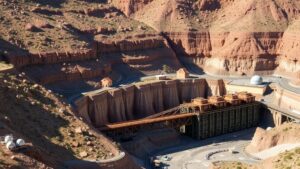How to Prospect for Copper in Porphyry Deposits at Surface Outcrops
How to Prospect for Copper in Porphyry Deposits at Surface Outcrops
Prospecting for copper in porphyry deposits is a cornerstone of mineral exploration, particularly given the substantial demand for copper in modern industries. Porphyry copper deposits are large, subvolcanic bodies associated with hydrothermal systems that are rich in copper, molybdenum, and gold. Identifying these deposits at surface outcrops is a vital component of exploration efforts. This article outlines effective strategies for prospecting for copper in these geological formations.
Understanding Porphyry Deposits
Porphyry deposits are typically characterized by disseminated mineralization, contained within a granite or diorite host rock. These deposits generally have a large footprint, often exceeding several square kilometers. The copper within these deposits is most commonly found in the form of chalcopyrite, bornite, and chalcocite.
- Geological Setting: Porphyry copper deposits are often located at convergent plate boundaries or volcanic arcs.
- Mineral Composition: Besides copper, these deposits can host valuable by-products such as molybdenum and gold.
Identifying Surface Outcrops
Surface outcrops represent exposure of mineralized rock due to erosion and are essential signs of porphyry systems. Finding a surface outcrop requires several systematic approaches:
- Geological Mapping: The initial step involves detailed geological mapping of the area, identifying rock types, structures, and alterations that indicate porphyry systems.
- Using GIS Technology: Geographic Information Systems (GIS) can aid in analyzing topographical features and previous mineralization datasets.
Fieldwork Techniques
Once potential copper-rich outcrop areas have been identified, fieldwork techniques must be employed to further assess the mineralization potential. Here are some vital fieldwork strategies:
- Rock Sampling: Collect rock samples from various locations within the outcrop for geochemical analysis to determine copper content.
- Geophysical Surveys: Techniques such as induced polarization (IP) and magnetic surveys can help to define subsurface features indicative of porphyry systems.
Geochemical Analysis
Following rock sampling, rigorous geochemical analysis is pivotal for confirming the presence of copper and other metals. Common methods include:
- X-Ray Fluorescence (XRF): A rapid tool widely used for trace element analysis in geological samples.
- Atomic Absorption Spectroscopy (AAS): This method serves to quantify copper levels in the samples accurately.
In a notable case study, at the Los Pelambres copper mine in Chile, detailed geochemical sampling led to the discovery of extensive copper resources that now form one of the largest copper mines globally.
Interpreting Results
After conducting fieldwork and analyses, it is essential to interpret the results critically. Map the distribution of copper concentrations and look for anomalies that may suggest a higher concentration of mineralization. Combined with geological data, this interpretation can help in understanding the porphyry systems size and grade.
Real-World Applications
Successful prospecting for copper in porphyry deposits has significant implications for sustainable development and mineral supply chains. For example, the Andean region in South America is known for its rich porphyry deposits. Companies like BHP and Freeport-McMoRan have implemented advanced technologies and sustainable practices to enhance exploration while minimizing environmental impacts.
Conclusion
Prospecting for copper in porphyry deposits requires a combination of geological knowledge, field techniques, and analytical methods. Once surface outcrops are identified, systematic approaches such as geological mapping, rock sampling, and geochemical analysis can lead to successful discoveries. With the increasing demand for copper and its strategic importance in technology and renewable energy applications, understanding and applying these prospecting strategies is essential for the future of mineral exploration.
Actionable Takeaways:
- Conduct comprehensive geological mapping to identify potential areas for prospecting.
- Use modern technologies such as GIS and geophysical surveys to enhance exploration accuracy.
- Use rigorous sampling and analytical techniques to ensure the accurate assessment of copper concentrations.



